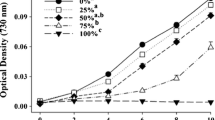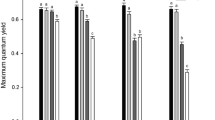Abstract
The accumulation of hydrophobic compounds by phytoplankton plays a crucial role in the biogeochemical cycle of persistent organic pollutants (POPs) in aquatic environments. We studied the accumulation of polycyclic aromatic hydrocarbons (PAHs) in the freshwater diatom Synedra acus subsp. radians during its cultivation with crude oil hydrocarbons, using epifluorescent and laser confocal microscopy as well as gas chromatography–mass spectrometry (GC/MS) analysis. Our results revealed that in the presence of crude oil or an extract of a crude oil/n-hexane solution (light oil), S. acus subsp. radians accumulated PAHs in its lipid bodies. During cultivation in the presence of a crude oil/n-hexane solution, the cells selectively accumulated C12–C18 alkanes, with a preference for C15 and C16 homologues. The length of n-alkane hydrocarbon chains accumulated in cells was similar to the acyl chains of fatty acids of the diatom. We therefore suggest that the insertion of n-alkanes into the membrane lipid bilayer promotes the transmembrane transport of PAH in diatoms. Our results confirm the hypothesis that diatoms play a role in the elimination of hydrophobic hydrocarbons from aquatic systems.





Similar content being viewed by others
References
Anderson JW, Neff JM, Cox BA, Tatem HE, Hightower GM (1974) Characteristics of dispersions and water-soluble extracts of crude and refined oils and their toxicity to estuarine crustaceans and fish. Mar Biol 27:75–88
Beakes G, Canter HM, Jaworski GHM (1988) Zoospore ultrastructure of Zygorhizidium affluens Canter and Z. planktonicum Canter, two chytrids parasitizing the diatom Asterionella formosa Hassall. Can J Bot 66:1054–1067
Beal R, Betts WB (2000) Role of rhamnolipid biosurfactants in the uptake and mineralization of hexadecane in Pseudomonas aeruginosa. J Appl Microbiol 89:158–168
Berglund O, Larsson P, Ewald G, Okla L (2001) The effect of lake trophy on lipid content and PCB concentrations in planktonic food webs. Ecology 82:1078–1088
Bopp SK, Lettieri T (2007) Gene regulation in the marine diatom Thalassiosira pseudonana upon exposure to polycyclic aromatic hydrocarbons (PAHs). Gene 396:293–302
Bouchez-Naïtali M, Vandecasteele JP (2008) Biosurfactants, an help in the biodegradation of hexadecane? The case of Rhodococcus and Pseudomonas strains. World J Microbiol Biotechnol 24:1901–1907
Capelli SM, Busalmen JP, De Sanchez SR (2001) Hydrocarbon bioremediation of a mineral-base contaminated waste from crude oil extraction by indigenous bacteria. Int Biodeterior Biodegrad 47:233–238
Carvalho RN, Bopp SK, Lettieri T (2011) Transcriptomics responses in marine diatom Thalassiosira pseudonana exposed to the polycyclic aromatic hydrocarbon benzo [a] pyrene. PLoS One 6:e26985
Castelli F, Librando V, Sarpietro MG (2002) Calorimetric approach of the interaction and absorption of polycyclic aromatic hydrocarbons with model membranes. Environ Sci Technol 36:2717–2723
Corner EDS (1978) Pollution studies with marine plankton. Part I. Petroleum hydrocarbons and related compounds. Adv Mar Biol 15:289–380
Croxton AN, Wikfors GH, Schulterbrandt-Gragg RD (2015) The use of flow cytometric applications to measure the effects of PAHs on growth, membrane integrity, and relative lipid content of the benthic diatom, Nitzschia brevirostris. Mar Pollut Bull 91:160–165
Dimitrov SD, Dimitorova NC, Walker JD, Veith GD, Mekenyan OG (2002) Predicting bioconcentration factors of highly hydrophobic chemicals. Effects of molecular size. Pure Appl Chem 74:1823–1830
Djomo JE, Dauta A, Ferrier V, Narbonne JF, Monkiedje A, Njine T, Garrigues P (2004) Toxic effects of some major polyaromatic hydrocarbons found in crude oil and aquatic sediments on Scenedesmus subspicatus. Water Res 38:1817–1821
Fabregas J, Herrero C, Veiga M (1984) Effect of oil and dispersant on growth and chlorophyll a content of the marine microalga Tetraselmis suecica. Appl Environ Microb 47:445–447
Furuno S, Foss S, Wild E, Jones KC, Semple KT, Harms H, Wick LY (2012) Mycelia promote active transport and spatial dispersion of polycyclic aromatic hydrocarbons. Environ Sci Technol 46:5463–5470
Gamila HA, Ibrahim MBM (2004) Algal bioassay for evaluating the role of algae in bioremediation of crude oil: I-isolated strains. Bull Environ Contam Toxicol 73:883–889
Gerofke A, Kömp P, McLachlan MS (2005) Bioconcentration of persistent organic pollutants in four species of marine phytoplankton. Environ Toxicol Chem 24:2908–2917
Gorshkov A, Marinayte I, Zemskaya T, Khodzher T (2010) Modern level of petroleum products in water of Lake Baikal and its tributaries. Chem Sustain Dev 18:711–718 in Russian
Greenspan P, Mayer EP, Fowler SD (1985) Nile red: a selective fluorescent stain for intracellular lipid droplets. J Cell Biol 100:965–973
Hong YW, Yuan DX, Lin QM, Yang TL (2008) Accumulation and biodegradation of phenanthrene and fluoranthene by the algae enriched from a mangrove aquatic ecosystem. Mar Pollut Bull 56:1400–1405
Hunt GR, Tipping LR (1978) A 1H NMR study of the effects of metal ions, cholesterol and n-alkanes on phase transitions in the inner and outer monolayers of phospholipid vesicular membranes. BBA-Biomembranes 507:242–261
Kallimanis A, Frillingos S, Drainas C, Koukkou AL (2007) Taxonomic identification, phenanthrene uptake activity, and membrane lipid alterations of the PAH degrading Arthrobacter sp. strain Sphe3. Appl Microbiol Biot 76:709–717
Karydis M (1980) Uptake of hydrocarbons by the marine diatom Cyclotella cryptica. Microb Ecol 5:287–293
Katagi T (2010) Bioconcentration, bioaccumulation, and metabolism of pesticides in aquatic organisms. In: Whitacre DM (ed) Reviews of environmental toxicology. Springer, New York, pp. 1–132
Khlystov OM, Gorshkov AG, Egorov AV, Zemskaya TI, Granin NG, Kalmychkov GV, Vorob’eva SS, Pavlova ON, Yakup MA, Makarov MM, Moskvin VI, Grachev MA (2007) Oil in the lake of world heritage. Dokl Earth Sci 415:682–685
Kingston PF (2002) Long-term environmental impact of oil spills. Spill Sci Technol B 7:53–61
Ko FC, Baker JE, Tew KS (2012) Kinetics of polychlorinated biphenyl partitioning to marine Chrysophyte Isochrysis galbana. Sci Total Environ 416:410–417
Konstantinova-Schlesinger MA (1961) Luminescent analysis. Physmatgiz, Moscow in Russian
Kontorovich AE, Kashirtsev VA, Moskvin VI, Burshtein LM, Zemskaya TI, Kostyreva EA, Kalmychkov GV, Khlystov OM (2007) Petroleum potential of Baikal deposits. Russ Geol Geophys 48:1046–1053
Kucklick JR, Harvey HR, Baker JE, Ostrom PH, Ostrom NE (1996) Organochlorine dynamics in the pelagic food web of Lake Baikal. Environ Toxicol Chem 15:1388–1400
Kusk KO (1981) Effects of hydrocarbons on respiration, photosynthesis and growth of the diatom Phaeodactylum tricornutum. Bot Mar 24:413–418
Lei AP, ZL H, Wong YS, Tam NFY (2007) Removal of fluoranthene and pyrene by different microalgal species. Bioresour Technol 98:273–280
Mackay D (1982) Correlation of bioconcentration factors. Environ Sci Technol 16:274–278
Mironov OG, Lanskaja LA (1967) The influence of oil on the development of marine phytoplankton. In: Vodyanitskiy, V.A. (ed.), Journal of Biooceanography. Moscow, pp 161–164 (in Russian)
Nizzetto L, Gioia R, Li J, Borga K, Pomati F, Bettinetti R, Dachs J, Jones KC (2012) Biological pump control of the fate and distribution of hydrophobic organic pollutants in water and plankton. Environ Sci Technol 46:3204–3211
Obaidy A, Hameed A, Jawad M, Lami M (2014) The toxic effects of crude oil in some freshwater cyanobacteria. J Environ Protect 5:359–367
Ozhan K, Bargu S (2014) Can crude oil toxicity on phytoplankton be predicted based on toxicity data on benzo (a) pyrene and naphthalene? Bull Environ Contam Toxicol 92:225–230
Ozhan K, Miles SM, Gao H, Bargu S (2014) Relative Phytoplankton growth responses to physically and chemically dispersed South Louisiana sweet crude oil. Environ Monit Assess 186:3941–3956
Patra D (2003) Applications and new developments in fluorescence spectroscopic techniques for the analysis of polycyclic aromatic hydrocarbons. Appl Spectrosc Rev 38:155–185
Pavlova ON, Zemskaya TI, Gorshkov AG, Parfenova VV, Suslova MY, Khlystov OM (2008) Study on the Lake Baikal microbial community in the areas of the natural oil seeps. Appl Biochem Micro+ 44:287–291
Popovskaya GI (2000) Ecological monitoring of phytoplankton in Lake Baikal. Aquat Ecosyst Health Manag 3:215–225
Popovskaya GI, Genkal SI, Likhoshway YV (2016) Diatoms of the plankton of Lake Baikal: atlas and key, 2nd edn. Nauka, Novosibirsk
Shishlyannikov SM, Zakharova YR, Volokitina NA, Mikhailov IS, Petrova DP, Likhoshway YV (2011) A procedure for establishing an axenic culture of the diatom Synedra acus subsp. radians (Kütz.) Skabibitsch. from Lake Baikal. Limnol Oceanogr-Meth 9:478–484
Shishlyannikov SM, Klimenkov IV, Bedoshvili YD, Mikhailov IS, Gorshkov AG (2014) Effect of mixotrophic growth on the ultrastructure and fatty acid composition of the diatom Synedra acus from Lake Baikal. J Biol Res-Thessalon 21:15
Sijm DT, Middelkoop J, Vrisekoop K (1995) Algal density dependent bioconcentration factors of hydrophobic chemicals. Chemosphere 31:4001–4012
Sikkema J, De Bont JA, Poolman B (1995) Mechanisms of membrane toxicity of hydrocarbons. Microbiol Rev 59:201–222
Smagunova AN, Karpukova OM (2008) Methods of mathematical statistic in analytical chemistry. Irkutsk State University, Irkutsk in Russian
Soto LA, Botello AV, Licea-Durán S, Lizárraga-Partida ML, Yáñez-Arancibia A (2014) The environmental legacy of the Ixtoc-I oil spill in Campeche Sound, southwestern Gulf of Mexico. Front Mar Sci 1:57
Subashchandrabose SR, Krishnan K, Gratton E, Megharaj M, Naidu R (2014) Potential of fluorescence imaging techniques to monitor mutagenic PAH uptake by microalga. Environ Sci Technol 48:9152–9160
Swackhamer DL, Skoglund RS (1993) Bioaccumulation of PCBs by algae: kinetics versus equilibrium. Environ Toxicol Chem 12:831–838
Thomas WH, Dodson AN (1974) Effect of interactions between temperature and nitrate supply on the cell-division rates of two marine phytoflagellates. Mar Biol 24:213–217
Tukaj Z (1987) The effects of crude and fuel oils on the growth, chlorophyll ‘a’content and dry matter production of a green alga Scenedesmus quadricauda (Turp.) Bréb. Environ Pollut 47:9–24
Verdin A, Lounes-Hadj-Sahraoui A, Newsam R, Robinson G, Durand R (2005) Polycyclic aromatic hydrocarbons storage by Fusarium solani in intracellular lipid vesicles. Environ Pollut 133:283–291
Wang L, Zheng B, Meng W (2008) Photo-induced toxicity of four polycyclic aromatic hydrocarbons, singly and in combination, to the marine diatom Phaeodactylum tricornutum. Ecotoxicol Еnviron Saf 71:465–472
Warner IM, Christian GD, Davidson ER, Callis JB (1977) Analysis of multicomponent fluorescence data. Anal Chem 49:564–573
Watkinson RJ, Morgan P (1990) Physiology of aliphatic hydrocarbon degrading microorganisms. Biodegradation 1:79–92
Acknowledgments
We thank Yu. Zakharova and N. Volokitina (Limnological Institute SB RAS) for their kind gift of the diatom culture and Prof. E. V. Likhoshway (Limnological Institute SB RAS) for her assistance in the preparation of this manuscript. This research was funded by the Federal Agency for Scientific Organizations (FASO). We would like to thank Dr. Teofil Nakov (University of Arkansas) and anonymous reviewers for their constructive comments. We also thank the United Instrumental Center (Irkutsk Scientific Center) and the Center of Ultramicroanalysis (Limnological Institute, Irkutsk) for providing the equipment. The experiments on S. acus subsp. radians growth in the presence of petroleum hydrocarbons as well as microscopic analyses were carried out within the Project VI.50.1.3. Qualitative and quantitative evaluations of hydrocarbons in samples were fulfilled within the Project VIII.76.1.5.
Author information
Authors and Affiliations
Corresponding author
Additional information
Responsible editor: Ester Heath
Rights and permissions
About this article
Cite this article
Shishlyannikov, S.M., Nikonova, A.A., Klimenkov, I.V. et al. Accumulation of petroleum hydrocarbons in intracellular lipid bodies of the freshwater diatom Synedra acus subsp. radians . Environ Sci Pollut Res 24, 275–283 (2017). https://doi.org/10.1007/s11356-016-7782-y
Received:
Accepted:
Published:
Issue Date:
DOI: https://doi.org/10.1007/s11356-016-7782-y




